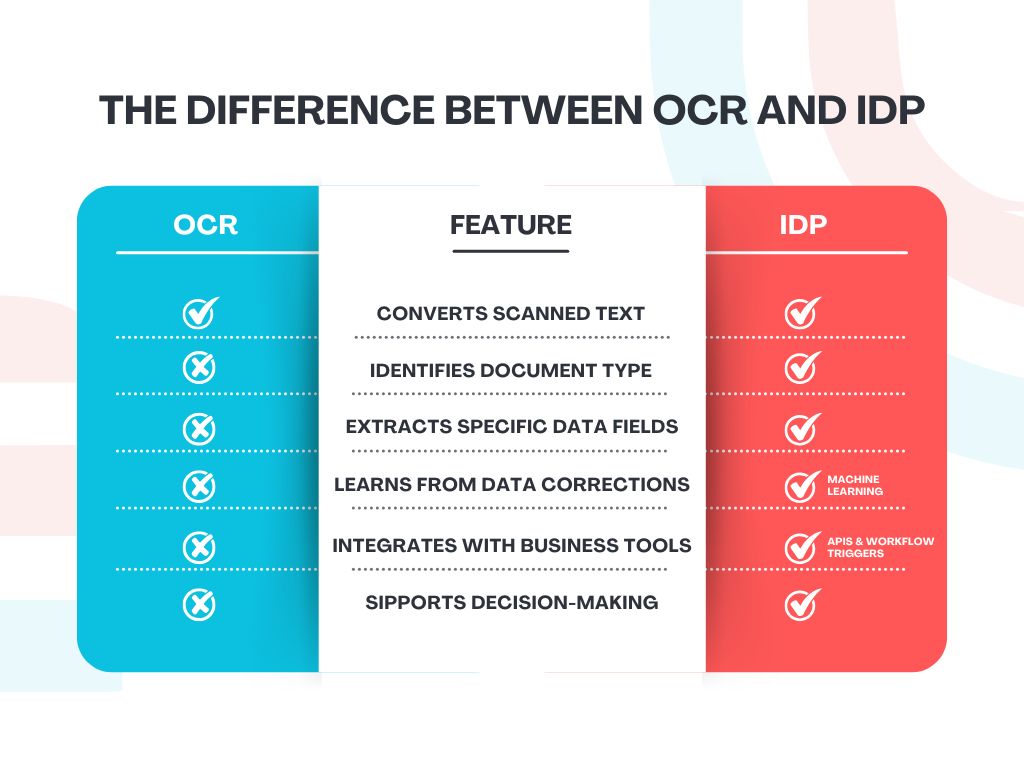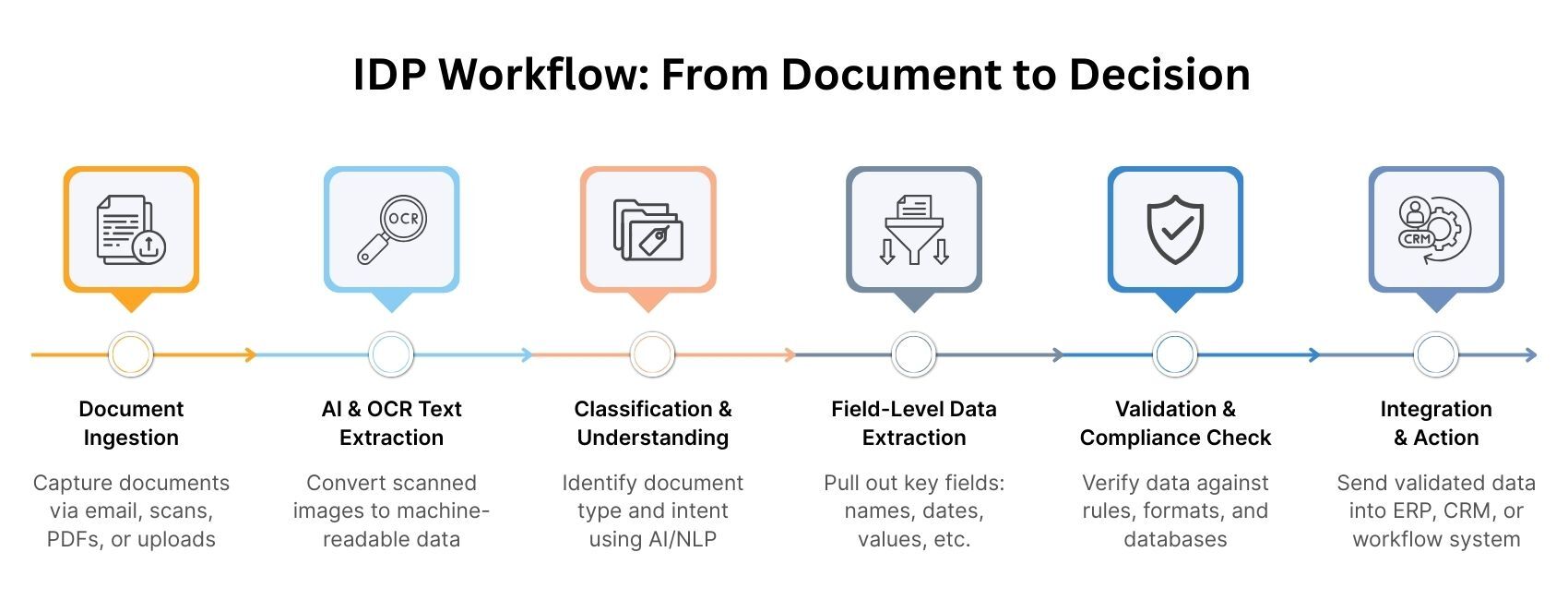The Changing Landscape of Document Processing
In today’s digital-first world, documents aren’t just digital files—they’re untapped sources of critical business data. But most companies still struggle to extract value from the mountains of invoices, contracts, forms, and emails they handle every day. That’s where Intelligent Document Processing (IDP) comes in.
Intelligent Document Processing is the next step in digital transformation. It doesn’t just scan or store your documents—it reads them, understands them, and turns them into structured, actionable information using a combination of AI, OCR (Optical Character Recognition), Machine Learning, and Natural Language Processing.
Whether you’re just starting to explore automation or want to optimize your document-heavy workflows, this guide will help you understand why IDP is becoming essential for businesses of all sizes.
In this guide, we’ll break down everything you need to know about Intelligent Document Processing:
What is Intelligent Document Processing (IDP)?
Definition:
Intelligent Document Processing (IDP) is a technology solution that uses Artificial Intelligence (AI), Optical Character Recognition (OCR), Machine Learning (ML), and Natural Language Processing (NLP) to automatically capture, understand, extract, validate, and organize data from unstructured documents like invoices, emails, forms, and contracts.
Unlike traditional OCR tools that just convert scanned documents into text, IDP interprets the context, classifies document types, pulls out relevant information, and sends it to other business systems—automatically and accurately.
Why Traditional Methods Fall Short?
Before IDP, document handling relied on manual data entry or basic scanning tools that:
These limitations led to slower operations, inconsistent records, and high processing costs.
IDP is Different
With IDP, your business doesn’t just digitize documents—it automates document intelligence.
It can:

Step 1: Data Capture
Technology Used: Optical Character Recognition (OCR), Computer Vision
IDP starts by “reading” digital or scanned documents—including PDFs, images, emails, and even handwritten forms. OCR extracts the text, while computer vision identifies structural elements like tables, headings, and logos.
Example: An invoice is uploaded; OCR reads the text while computer vision distinguishes columns and line items.
Step 2: File Classification
Technology Used: Machine Learning, Natural Language Processing
The system then identifies the type of document—invoice, resume, contract, application form—based on content, layout, and patterns. This classification helps the system know what information to extract next.
Why It Matters: A purchase order and a contract might both mention dates and names, but IDP understands their context and purpose.
Step 3: Data Extraction
Technology Used: AI, NLP, ML
Once classified, IDP extracts key fields like:
- Names
- Invoice numbers
- Dates
- Amounts
It pulls this data into a structured format (JSON, XML, or database fields).
Pro Tip: You can train the system over time to recognize new field types for custom document formats.
Step 4: Data Validation
Technology Used: Business Rules, AI, Database Matching. Now the extracted data is verified:
- Does the invoice number match existing records?
- Are the totals accurate?
- Are the dates in the correct format?
This stage ensures clean, error-free data by cross-referencing internal systems or external databases.
Human in the Loop: If data is missing or mismatched, the system can flag it for human review.
Step 5: Secure Storage
Technology Used: Document Management System (DMS), Metadata Tagging, Encryption
The verified data and documents are stored securely in the cloud or on-premises:
- With metadata tags for fast search
- Compliant with standards like HIPAA, GDPR, or SOC 2
- Encrypted and access-controlled
Bonus: This enables long-term archiving, audit readiness, and compliance reporting.
Step 6: Integration with Business Systems
Technology Used: APIs, Workflow Engines, RPA
IDP doesn’t just store the data—it shares it:
- Sends validated invoice data to your accounting system
- Updates customer info in your CRM
- Triggers approval workflows
By connecting with ERPs, CRMs, and databases, IDP ensures a continuous flow of real-time, reliable data across your business.
With the workflow mapped out, the next logical step is to explore the key technologies powering IDP—from AI to NLP and beyond.
Why Intelligent Document Processing Matters: Top Business Benefits
Intelligent Document Processing (IDP) does more than just speed up paperwork. It creates tangible business value by automating document-heavy workflows and reducing dependency on manual labor.
Here’s how IDP delivers across industries:
Now that you’ve seen what IDP can do for your business, let’s explore how it’s used in real-world scenarios—across industries and roles.
Want to Dive Deeper?
Download Our Free eBook
Learn how Docupile helps real businesses automate their document workflows using OCR, AI, and machine learning.
Download the eBook: Unlocking the Power of Intelligent Document Processing —->>>
Who Uses Intelligent Document Processing? Key Personas and Use Cases
To make IDP actionable, let’s break it down into personas—roles that benefit from Intelligent Document Processing—and the real-world use cases where it delivers high ROI.
“IDP is not just about automation—it’s about empowering roles across your organization to move faster, think smarter, and stay compliant.”
Now that you know who uses IDP and how, let’s see how it stacks up against traditional document processing methods—especially basic OCR and manual workflows.
How Does Intelligent Document Processing Compare to Traditional Methods?
While many businesses have adopted some level of digitization—like scanning paper into PDFs or using basic OCR—traditional document handling still relies heavily on manual labor. That’s where Intelligent Document Processing (IDP) changes the game.
Here’s how IDP compares with conventional methods:
| Feature | Traditional Document Processing | Intelligent Document Processing (IDP) |
|---|---|---|
| Text Conversion | Basic OCR or manual entry | OCR + AI-based interpretation |
| Document Classification | Manual sorting | Automated ML-based classification |
| Data Extraction | Manual copy-paste or rule-based | Intelligent pattern recognition with AI |
| Validation & Verification | Done manually | Auto-validation with rules + ML |
| Processing Time | Slow (hours or days) | Fast (minutes or less) |
| Error Rate | High (due to human input) | Low (continuous learning via ML) |
| Workflow Automation | Limited or nonexistent | Fully automated with RPA/API integrations |
| Scalability | Labor-dependent | Scalable across thousands of documents |
| Integration with Systems | Rare or complex | Built-in API/ERP/CRM connectivity |
| Search & Retrieval | Time-consuming | Instant with metadata and indexing |
| Compliance & Audit Logs | Manual recordkeeping | Auto-generated logs and access controls |
What Makes IDP the Future?
Now that you’ve seen the clear edge Intelligent Document Processing offers over traditional methods, let’s wrap up with some frequently asked questions to address common concerns and hesitations.
The Technologies That Power Intelligent Document Processing
Intelligent Document Processing (IDP) doesn’t rely on one tool—it’s a synergy of multiple advanced technologies working together to extract, understand, and act on document data. Here’s a closer look at the engines driving IDP.
With these technologies working together, Intelligent Document Processing becomes more than just automation—it becomes a strategic asset. But how does that translate into real value for businesses?
Up next: the benefits of Intelligent Document Processing—quantified, practical, and tailored to real-world use cases.
FAQs: Everything You Need to Know About IDP
With questions answered, it’s time to explore how you can put IDP into action in your business—starting with a smarter platform built for scale and simplicity.
Docupile: Your Smart Assistant for Intelligent Document Processing
You’ve seen how Intelligent Document Processing transforms document chaos into structured, actionable data. Now, imagine having a platform that brings all these capabilities to your fingertips—without complexity, heavy IT lift, or long deployment cycles.
That’s where Docupile comes in.
Why Docupile is Built for Your Business?
Real-World Results
Ready to bring intelligence into your document processing?
Book a Free Demo and see how Docupile simplifies your workflows, boosts productivity, and helps you stay ahead of the curve.
Because in today’s world, your documents should work as smart as your team does.





